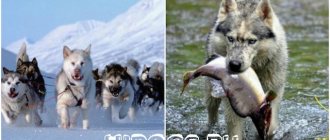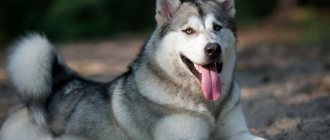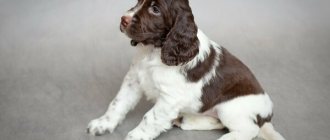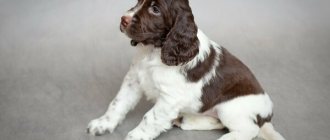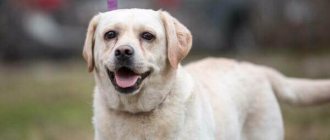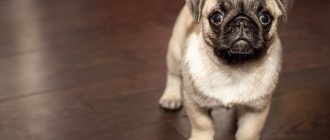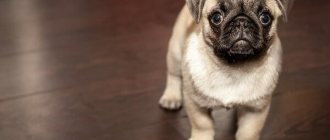Huskies, for all their pretty appearance and friendliness, have an obstinate character that not every dog breeder can cope with.
Despite this, puppies of this breed require attention and caring care.
Because, being babies, they are completely defenseless.
What newborn puppies look like in the photo and when they open their eyes
Newborn husky babies do not have any fundamental differences from other breeds . They have thick paws, the coat is usually white, but has distinctive spots that correspond to the future coat color.
They are absolutely helpless, their eyes and auditory canals are closed, there is no thermoregulation, and of all the senses, only smell is relatively developed, with the help of which they find their mother and cling to her in search of food and warmth.
It is impossible to predict exactly when a puppy's eyes will open - it is very individual . As a rule, this happens 11-16 days after they are born, but huskies begin to see well only at about 3 weeks of life.
It may happen that only 1 eye or both open, but only half, this is not scary, after a few days the eyes will open completely.
If the eyes have not opened a month after birth, you should take the puppy to the veterinarian.
Most puppies are born with blue eyes, but by 6 months the color of the iris may change. Representatives of this breed are also characterized by heterochromia.
Dimensions and weight of newborn huskies
The weight of puppies depends on gender and litter size; on average, huskies are born weighing 350-500 g.
How much do husky puppies cost?
Prices vary from 20 to 80 thousand, depending on various factors.
How to choose?
You should choose for the soul, and not for external qualities. The puppy must suit your personality.
At what age should I take it?
A few days after the puppy becomes completely independent of its mother's milk. Usually this is 4–6 weeks.
How to determine age?
Based on a set of factors, such as height, weight, physique, behavior. From them you can roughly determine the age of the puppy.
Where is the best place to buy?
From trusted breeders on a personal visit. Where it is possible to determine living conditions, quality of food and treatment of animals. Find out more and see the puppy's mom and dad.
Who is better?
The best pet is the one that is loved. Girls are more active. They are more cunning and wayward than boys. Boys, on the contrary, are calmer and more devoted to their owner.
Price depending on type
There are only 5 types of huskies:
- Alaskan Husky (25–50 thousand rubles);
- Mini-husky (from 60 thousand rubles);
- Sakhalin Husky (20-30 thousand rubles);
- Siberian Husky (20-80 thousand rubles);
- Japanese husky (from 70 thousand rubles).
Purity of the breed
Determined by the absence of any defects and full compliance with the standard.
How to determine whether a husky or a crossbreed?
A purebred dog can be easily identified by its build, eye color, coat color and pedigree traits. Such as ear placement, tail position, etc.
How much does a purebred puppy cost?
A purebred puppy costs from 30 thousand rubles. and higher. The cost of a mixed breed usually does not exceed 20 thousand rubles.
Eye color
The breed is characterized by blue-eyed individuals. It is not uncommon to see dogs with different eyes . Also acceptable eye colors for the breed are amber, gray, and black.
Price with pedigree
The price tag for an individual with a pedigree starts from 50 thousand rubles, if there are titled parents. A puppy without documents will cost less than 20 thousand rubles .
average price
The average price for a representative of this breed in Russia is higher than abroad.
When choosing a husky, you should study in detail all the features of the breed, understand, first of all, for yourself, whether it suits your rhythm of life and whether you can satisfy all its needs, and not decide to take such a serious step just because of fashion.
How it develops week by week in the first month
The first month of a puppy’s life is associated with their constant changes and the most intensive development.
During the first 10 days after birth, babies go through a phase of primary adaptation to the conditions of the world around them, especially to temperature and smells.
At this time, puppies grow very rapidly, almost doubling their body weight in the first week of life . They become more active and the breeder can already assess which of the babies in the litter is stronger and which is weaker.
Stronger puppies are the first to crawl to the nipples, pushing away those who are a little weaker; they gain weight faster and open their eyes earlier.
At about 11-16 days, puppies' eyes open, and at 17-18, their auditory canals open . Little huskies continue to adapt to their environment, they can already see objects and hear sounds.
By 16-18 days, milk teeth begin to erupt, first the back ones, later the front ones.
The nose of the nose acquires uniform pigmentation by the 4th week of life of puppies; during the same period, the palate of babies darkens, and black spots appear on the lips.
At the age of 3 weeks, Husky puppies walk well, and at 1 month they run confidently.
Switching to adult food
During the first days of their lives, puppies depend on their mother. Newborns can only crawl to their warm mother, find nipples, and suck milk.
On days 18-21, the sucking reflex gradually fades away and the next transition period begins.
Interest in meat and solid foods appears. Now the reaction to irritation of the oral cavity is not sucking, but chewing movements. The enzymes responsible for digesting meat food mature in the dog’s body. The first teeth are emerging. Some bitches regurgitate puppy food.
Your pet’s sense of smell, hearing, and vision are already quite mature. It is during this period that the transition from dairy to mixed nutrition begins. Complementary feeding should start with liquid or porridge feed.
Whether it will be specialized or natural food depends on what you plan to feed the dog in the future. At first, the dog doesn’t pay much attention to the innovation, since his mother’s milk is still his main food.
You cannot force your puppy to eat food.
You can gently poke his muzzle into the food bowl or put a tiny portion in his mouth. Canned food should be mixed in a 1:1 ratio, dry food should be soaked in three parts of water. The raw frozen beef is scraped off with a knife and rolled into small pea-sized balls. Complementary foods are introduced gradually, observing the reaction from the gastrointestinal tract of your pets.
From the very beginning of introducing complementary foods, it is necessary to provide a sufficient amount of fresh drinking water.
When do puppies start eating on their own? From about one month of age, puppies can already eat from a bowl themselves. The owner should make sure that all the kids eat enough, because stronger dogs will eat food from weaker ones.
Development from 1 to 12 months
| Age | Male height at withers, cm | Male back length, cm | Height of the bitch at the withers, cm | Bitch's back length, cm | Weight, kg | Description |
| 1 month | – | – | – | – | 2,7 | Babies are actively growing, already 2 weeks after birth their body weight increases by about 3 times |
| 2 months | 32 | – | 30 | – | 5,9 | The puppies are already well built, confidently move independently, their ears are starting to stand up |
| 3 months | 42 | – | 40 | – | 10,5 | Babies need to be fed 5 times a day, the accelerated growth rate continues |
| 4 months | 48,4 | 50 | 47 | 50 | 14,3 | Puppies begin to take on adult characteristics |
| 5 months | 53 | 54 | 51 | 52,5 | 19,5 | Husky lines and traits continue to develop |
| 6 months | 55 | 57 | 53 | 54 | 21,5 | The dog is already big and tall, but it is still a puppy, continuing to form |
| 7 months | 57 | 58 | 55 | 55 | 24,3 | The dogs are practically no different from adult representatives of the breed. |
| 8 months | 58 | 59,5 | 56 | 56,5 | 25,5 | Puberty, growth rate slows down |
| 9 months | 59 | 60 | 57 | 57,5 | 26,5 | Height at the withers is the same as that of an adult |
| 1 year | 60 | 62 | 58 | 59 | 28 | An adult dog, the period of growth and weight gain has stopped, but formation continues |
Summing up
There is no place for subjective judgments in the life support of such a complex breed as the Siberian Husky. To correctly assess the exterior of a pet and its dimensions ( height at the withers / weight ), there is a “reference point”, the registry standard of the husky breed .
The dog’s compliance with the declared parameters formats exhibition and breeding activity and is an excellent tool for normalizing the diet and monitoring the health of the pet.
- care
- Husky
If you find an error, please select a piece of text and press Ctrl + Enter.
To what age do they grow? When do your ears stand up?
Huskies, like representatives of most other large breeds, take quite a long time to develop.
Up to about six months, males and females develop approximately the same, but after 6 months some differences are observed:
- females - active development lasts until about 8 months, when the dog begins its first heat, after which growth slows down slightly, but continues up to 1 year, the final formation of the dog is completed by 2 years;
- males - active growth continues up to 9 months, after a slowdown, development lasts up to 1.5 years, the husky boy is finally formed by about 2.3 years.
The time when a puppy's ears stand up is difficult to predict . This depends on nutrition, the size of the litter in which it was born, heredity and the individual characteristics of the individual.
As a rule, ears stand up at about 2 months, but up to six months is considered normal.
Ears may fall off during teething and after vaccination..
If your pet's ears are not standing up by 6 months, you should contact a veterinarian - they will probably need to be glued back.
Breed standard
The Siberian Husky is a medium-sized working dog. For hundreds of years it was used as a riding vehicle. Today this breed is very popular, and this is not surprising. Despite her powerful appearance, she is kind to children, affectionate, and very faithful to her owner.
An adult dog has a muscular body and strong bones. Males are seasoned and hardy, but are not distinguished by rudeness, females are graceful, although they have developed muscles.
What are the breed standards?
In dogs that are black, red and gray in color, the nose is black, in dogs of a copper shade it is chestnut, in snow-white dogs it is flesh-colored. The muzzle is average in length and width, becoming narrower closer to the ears. The lips are pigmented and fit tightly. The slightly slanted eyes of the husky are mesmerizing. Eye colors are brown and blue. The look of a dog of this breed is piercing, but friendly and not without a hint of mischief. The ears are medium in size, stand vertically upward, are close to each other, and have a triangular shape.
During the stance, the husky holds his head proudly raised. The beautiful curved neck gives the dog a proud posture. The back is straight. The tail is of the “fox” type, equally pubescent on all sides. When the dog is tense, the tail is raised and resembles a sickle. The coat is “double” of medium length. The coat is dense, but not long. When the dog moves, the tail does not curl to the side. Colors are allowed from black to snow-white. There may be markings and various patterns on the head.
Similar article: History of origin and description of the Shar Pei breed
So, the main characteristics of the breed:
- the average size;
- proportionate strong body;
- correct tail;
- dense and coarse coat;
- friendly character;
- high degree of endurance.
Basic rules of care
Husky is one of the most unpretentious breeds that does not require specific labor-intensive care..
The puppies are mainly cared for by the female, the main responsibilities for caring for the pets fall on the breeder only when the babies reach 2 months, before which they require minimal effort.
Wool and bathing
The husky's coat needs to be brushed several times a week, and daily during seasonal shedding.
Huskies cannot be bathed until the quarantine is over after the last vaccination . The earliest age when a baby can be bathed in case of emergency is 4 months.
The water should be approximately +28 °C, and a rubberized mat should be placed on the bottom of the bath to prevent the puppy’s paws from slipping.
First, you need to lather your pet with a special shampoo designed for puppies, then rinse off the foam with water, making sure that it does not get into the dog’s ears and eyes.
After this, you need to dry the dog with a towel and dry the undercoat thoroughly..
Claws
The first time puppies need to trim their nails is when they are 9 days old, then at about 3 weeks, and then as they grow.
In adult dogs, the nails, as a rule, grind down on their own during walks, but if this does not happen, they need to be shortened with a nail clipper once every 3 weeks..
Ears
Inspect once a week and clean if necessary. To do this, you need to drop a special lotion into your ears, massage the ears and wipe off the wax with a napkin. Do not deep clean your ears using cotton swabs.
If brown discharge, swelling or other symptoms of pathology are detected, you must show the puppy to a veterinarian.
Eyes
Inspect and wipe daily with a cotton pad soaked in warm boiled water or chamomile infusion.
Teeth
To avoid the formation of stones, your pet’s teeth must be cleaned of plaque every day using a special brush and paste.
Bitch after giving birth
Try to be there for a few days after giving birth.
If the bitch had a caesarean section, in the first days after the operation she will not be able to independently care for the offspring. You will have to take this responsibility upon yourself. Massage the babies' bellies with a damp, warm cloth. Having recovered from anesthesia, the bitch may be shocked: where did so many new residents come from? There is a high probability of such a development of events if this birth is her first. When the puppies start crawling around and looking for the nipple, this can make the bitch nervous. Therefore, when the animal has completely recovered from anesthesia, place one puppy in its bed and monitor the reaction. Only if everything went well, can you move all the other kids there. The mother will be cautious and a little aggressive with them until she gets used to it. So try to be there constantly for a few days after giving birth. If this is not the first litter, she will accept them normally and will properly care for the puppies, even with an unhealed suture . In order not to harm the mother, you can keep her newborn babies separately for several days, in a box with a heating pad, placing them next to it only during the feeding period.
If the bitch has no interest in babies, she may be sick. Call a veterinarian immediately for an examination.
Useful information: You should not leave the mother alone with the puppies if this is her first litter. Not every dog exhibits maternal instinct; without supervision, it can harm babies (gnaw off limbs or even eat them completely). Fortunately, this rarely happens. Most often, after a few days, the mother gets used to her role.
How to toilet train
Until the end of the quarantine period after vaccination, the puppy cannot be taken outside, so at first it is necessary to teach him to relieve himself in the house, in a specially designated place.
To do this, you need to limit the pet’s space by allocating him 1 room or part of it, covering the entire floor in it with newspapers or diapers - this will not allow the puppy to go to the toilet by.
Every time your husky relieves itself in its diaper, you need to praise and encourage it. Gradually, the number of diapers should be reduced until only 1 remains, which can eventually be replaced with a tray.
If for some reason it is impossible to limit the dog's space, you should place as many diapers as possible throughout the house, especially near doors and windows.
Often the dog itself chooses a place for the toilet, in which case a diaper should also be placed there, even if it is the center of the room.
NOTE!
After eating, sleeping and active play, the puppy should be taken to the toilet and not allowed to leave until he relieves himself. After this, the dog must be praised and treated with a treat.
When your husky is 6 months old, you can begin to train him to use the toilet outside . To do this, you need to take the dog out for a walk every 40-60 minutes. after feeding and wait until she goes to the toilet.
It may happen that the puppy, out of habit, waits until he gets home to go to the litter box, then in the future you need to take a newspaper or diaper soaked in urine with you and increase the time of walks.
What do we have to do
If there is a clearly thought out scheme, then acting on it is much easier. After all, if you just dream about those days when the puppy stops peeing at home, it won’t make them come any faster. You can proceed as follows. In almost all apartments, the toilet is located close to the front door. Therefore, we slowly move the puppy’s tray to the toilet and teach him how to use it. The door should be left ajar so that the baby can push it with his paw. When this moment passes, the door closes.
Then everything depends on you. As soon as the puppy gives a signal that he wants to go to the toilet, that is, he pushes the door with his paw, you grab the leash and run out into the street with him. You can’t wait long, so if it’s not frosty outside, try to act quickly. Of course, you will have to constantly take time off from your work, but you just need to get through this period.
What to feed for the first 3 months?
From birth to 2-3 weeks, the puppy eats only mother's milk. If for some reason breastfeeding is not possible, you should purchase a special milk replacer, for example, Royal Canin Babydog Milk.
When bottle-feeding, after eating, the puppy needs to massage the belly and genital area with a damp cotton pad..
As the first complementary foods, you can give your babies calcined cottage cheese and goat's milk.
At 1 month you need more supplementary feeding . This can be industrial food appropriate for the baby's age.
If we are talking about natural products, your little husky should be supplemented with whole milk or infant formula without additives, calcined cottage cheese, boiled yolk mixed with milk, boiled minced beef, and low-fat broth.
At 2 months, the puppies have already erupted all their milk teeth; their diet can include pre-frozen scraped raw meat, vegetables, herbs, cereals, eggs, fruits, and dairy products .
At the age of 3 months, puppies are already moving to new owners, who can change their type of food at their discretion. However, this must be done gradually and no earlier than 2 weeks after purchasing the pet.
At this age, the puppy can eat all foods from the list of allowed foods . If some of them are new to the baby, you need to give them a little and gradually, carefully observing the husky’s reaction to the new product.
If the problem returns
It also happens. The breeder informs the owner of the approximate time frame at which the puppy stops peeing at home. This is usually closer to 6 months of age. But sometimes after a while the owner is faced with the fact that puddles and piles begin to appear again. If we are talking about a young dog, then the problem is most likely psychological in nature:
- Excessively strong emotions. When a dog is happy to meet its beloved owner, it may wet itself. Or she is afraid of punishment for the trick. If people yell at a dog and beat it for mischief, it will do more mischief.
- The reason may also be longing for the owner. Experiments were conducted when cameras were installed in the homes of puppy owners who complained about such problems. As a result, it was possible to see that when the owners are at home, the dog behaves perfectly. She asks to go to the toilet, she is calm and happy. But as soon as they leave, she begins to rush and howl. Sometimes, unable to withstand the melancholy, she relieves herself and nervously gnaws on things.
- Problems of master's authority. A young dog may tend to be dominant. And if the owner demonstrates excessive gentleness, then the pet feels unpunished.
It happens that several months of training go to waste, and, at first glance, it is not clear why. The puppy stopped peeing on the diaper or the teenager began to relieve himself in the corners - pay attention to the points listed above. Perhaps the problem can be solved quite simply.
How to feed correctly and how often
Proper feeding is the key to healthy development of a puppy. It is important that the diet is balanced and includes all the necessary vitamins, nutrients, macro- and microelements.
The number of daily feedings depends on the age of the dog:
- up to 8 weeks – 6 times;
- 2-3 months – 5 times;
- 4-6 months – 4 times;
- 6-10 months – 3 times;
- from 1 year and older – 2 times.
Improper nutrition, especially during the period of active growth of the puppy, can lead to the development of pathologies.
Weekly menu for a puppy 4-5 months old
| Day of the week | Menu |
| Monday | Beef, rice porridge, vegetable oil, sour cottage cheese, stewed vegetables, egg, kefir, grated apple |
| Tuesday | Rabbit meat, buckwheat porridge, vegetable oil, calcined cottage cheese, stewed vegetables, kefir, apple |
| Wednesday | Turkey, rice porridge, vegetable oil, cottage cheese, stewed vegetables, egg, yogurt, apple |
| Thursday | Salmon, buckwheat porridge, vegetable oil, sour cottage cheese, stewed vegetables, yogurt, apple |
| Friday | Pink salmon, rice porridge, vegetable oil, calcined cottage cheese, stewed vegetables, kefir, apple |
| Saturday | Beef, rice porridge, vegetable oil, calcined cottage cheese, stewed vegetables, egg, kefir, apple |
| Sunday | Turkey, buckwheat porridge, vegetable oil, sour cottage cheese, stewed vegetables, yogurt, grated apple |
Portions should be measured according to the activity level and health of the individual..
Which dry food to choose
Budget food of economy class, such as, for example, Pedigree, Chappi, Darling, ARO, is not suitable for feeding huskies..
They contain artificial colors, flavors, preservatives, flavor enhancers and other additives that have a negative impact on the dog's health.
Also, such foods contain low-quality by-products, grains, and do not contain vitamins and minerals necessary for the growth and development of the pet.
Premium, super-premium and holistic foods are suitable for feeding representatives of this breed.
The most popular food brands are Nutra Gold, Advance, Purina Pro Plan (especially the Sensitive Salmon, Medium Robust Health, Medium Robust, Medium Puppy Sensitive, Royal Canin, Happy Dog lines (Maxi Baby and Nature Croq lines).
Useful video
From the video you will learn everything about the Husky dog breed:
Probably the most popular and photogenic dogs today are the Husky breed. This breed gained its popularity due to the fact that it saved the settlement of Nome from diphtheria at the very beginning of the 20th century. Further, thanks to selection, the breed was improved and today has reached the peak of popularity. In addition to the fact that huskies can be used as sled dogs, today they are more preferred as pets.
How to stop biting?
Representatives of this breed are not characterized by aggressive behavior.
If a puppy under the age of 4 months bites the owner and other family members on the arms or legs, this is normal . Most likely, this is how the little husky shows his emotions and encourages him to play with him.
However, this behavior should not be encouraged, otherwise the pet will decide that this can always be done.
It is important from an early age to show the husky who is the leader in the house, to let him understand that he is not the leader of the pack . For any manifestation of aggressive behavior and attempts to bite someone, it is necessary to demonstrate your strength to the puppy, while avoiding physical punishment.
It is enough to pull the dog by the collar so that its muzzle is pressed to the floor, and hold the animal in this position for several seconds.
After this, defiantly ignore the pet for another 2-3 minutes, emphasizing your dissatisfaction with its behavior..
Ailments
Puppies of this breed are characterized by various ailments, both funny and unpleasant.
Why does he hiccup frequently?
Puppies may hiccup frequently for a variety of reasons. If the hiccups are short-lived, then most likely the pet is thirsty after a vigorous game, or he filled his stomach too quickly, or the dry food was too dry. In any case, you need to give your pet something to drink.
REFERENCE. Before feeding the puppy, it is better to soak the dry food in water.
Hiccups can also be caused by a foreign body stuck in the stomach. If your puppy is prone to frequent bouts of hiccups, you should contact your veterinarian.
Breathes quickly
If the puppy, being in a static position, has rapid breathing, then most likely he is sleeping. The fact is that sleeping dogs, when their sleep reaches the rapid phase, tend to dream. In these dreams, they can experience the same emotions as in real life, and rapid breathing is proof of this.
But if your pet breathes more often than 10-30 breaths per minute while awake, this is a reason to show it to the veterinarian. Since this is already a symptom of respiratory disease.
Diarrhea
If diarrhea is not accompanied by vomiting, fever, dizziness and drowsiness, it is necessary to change the puppy’s diet. In cases where all the symptoms are together, the only vital decision is to take the dog to the veterinarian.
Dandruff
One of the reasons for the appearance of dandruff may be the presence of parasites in the puppy, such as worms and hair mites. Regular deworming will help get rid of them. If your pet does not have any of these, then there is a lack of vitamin A. High-quality food, shampoo and vitamin supplements will correct the skin condition. In a situation where a vitamin-enhanced diet does not produce results, you should think about skin fungus. In this case, only a veterinarian can get rid of the disease.
How to train and what commands to teach?
The table below describes how to teach your husky puppy commands.
| Team | Education |
| To me | After the pet remembers the name and begins to associate itself with it, you need to call it by name, clearly saying “Come!” When your pet approaches, you need to praise him and give him a treat. |
| Near | During a walk, the dog should walk at the owner's left foot. In order for the pet to remember this, you need to say the command “Nearby”, pull the leash, holding it in the right place and not allowing it to move to the side or overtake the owner |
| Sit | Pull the leash up, forcing the husky to raise its head, then say the command and lightly press the dog on the rump so that it sits |
| Ugh | When the puppy does something prohibited, for example, tries to eat something on the street, you need to grab it by the withers, shake it and clearly say “Ugh.” |
Exhibition animals must also master the commands “Show your teeth” and “Give me your paw.”.
It would be a good idea for any dog to learn the commands “Place” and “Lie Down”, and if you plan to use a husky as a sled dog, then training for the commands “Forward”, “Right/Left” and “Stay” will be required.
Consult your doctor
Sometimes the problem lies in your pet's physiology. For example, a female dog may continue to pee periodically at home until she is two years old. This is due to the formation of the hormonal system. Periodically, the dog begins to leave a number of small puddles. This is a phenomenon that goes away after the first birth or with age. It occurs, according to statistics, in one out of 5-7 females. If the problem appears in a young dog that has been trained to relieve itself on the street, then pay attention to the following factors:
- In cold weather, a dog can catch a cold. This leads to various kinds of inflammatory processes. It is possible that increased urination is a consequence of this.
- Jealousy. If the family has a child, a cat or another dog, then your pet may simply start leaving puddles out of jealousy. Or maybe mark the territory, showing the “newcomers” who is boss in this house.
- Severe stress.
As you can see, the question of how many months a puppy stops peeing at home remains open: there are too many nuances here. But normally this happens at 6-7 months.
When is weaning from the mother?
Up to 3 weeks, the puppy is completely dependent on the mother, who not only feeds and warms him, but also licks him, stimulating urination and bowel movements.
Approximately on the 20th day after birth, you need to start introducing complementary foods into the puppies' diet, after which the baby will become more and more independent every day, the bitch will only raise him and teach him basic norms of behavior.
The puppy is ready to go to a new home at 8-12 weeks.
This is the most suitable age for buying a pet - the baby is no longer dependent on the mother, but is not yet accustomed to the owners, he has not yet developed any habits, so adaptation to the new home will be as easy as possible.
First steps
The newborn is able to crawl slightly to reach the nipples and its brothers and sisters (crowding response) when the mother is not present. While the dog cannot walk, he constantly moves his paws in his sleep. This is the only alternative to make your muscles train.
This type of sleep is called active sleep.
When do puppies start walking? At 18-21 days of life, small dogs begin to stand on their paws, sway, and walk a little. Puppies are no longer so helpless - they see and hear. And now they are trying to get out of their den, playing and biting each other.
How to choose?
You should purchase a puppy from a specialized nursery from trusted breeders - this will eliminate the possibility of buying a mixed breed or a dog with any pathologies or deviations from the standard .
Before purchasing, it is important to inspect the conditions of keeping dogs in the kennel, meet the parents of the future pet, and learn about their health and characteristics.
puppy that meets the standard :
- shiny, soft and fluffy coat, without bald spots and dandruff;
- bright, clear eyes without signs of inflammation and increased lacrimation;
- wet cold nose;
- scissor bite, no plaque on the teeth;
- ears are clean, without unpleasant odor;
- There are no signs of rash or irritation on the skin.
The baby must be developed according to his age, have a good appetite, show curiosity, behave actively, playfully, but in no case aggressively.
A bloated belly, excess weight and exhaustion are signs of illness.
Nutritional Features
The husky's body has some peculiarities. A huge amount of protein and fatty foods does not harm him at all. Unlike the body structure of other animal breeds, the husky's digestive system does not require a lot of carbohydrates.
It has been noted that huskies are low eaters, despite their great physical endurance and energy. However, even among this breed there are gluttons with a good appetite. If an individual likes to eat a lot, then the owner needs to carefully monitor the volume of its portions. Otherwise, there is a risk of the dog developing obesity and health problems.



